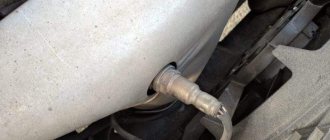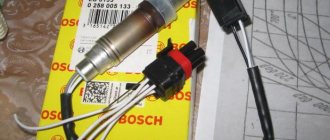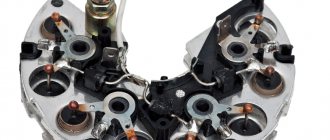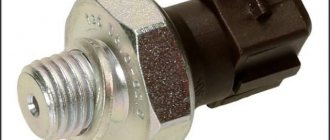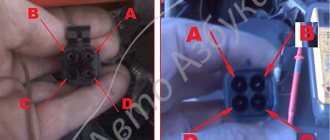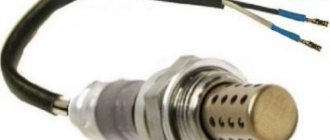A malfunction of the lambda probe is accompanied by diagnostics and, in some cases, replacement of the part. This component of the car system protects the ecology of the planet. Its main function is to control the level of harmful substances in exhaust gases.
The automotive market offers two main types of lambda probe:
- With two-channel layout. It was installed on cars manufactured more than 30 years ago. This probe is also used for economy class cars.
- Broadband device. Used for most mid- and premium-class cars. The device more accurately detects excess levels of harmful substances and reports this to the driver.
The part is installed inside a special manifold where hoses and pipes are connected. Installation in this location allows for high performance and diagnostic accuracy. The main function of the lambda probe is to increase the vehicle's operating resources, reduce fuel consumption and maintain stable engine operation. If a discrepancy occurs, the device sends a signal to the ECU, which changes the proportions of fuel and air.
The importance of this device is underestimated by many, but if it fails, the machine may become unstable. For this reason, it is important to know the main problems of the probe and how to deal with them.
Symptoms of a malfunctioning lambda probe
Signs of malfunction of this device can be different, and the most important signal for the driver will be a violation of the normal operation of the engine. If the device does not work well, the quality of the fuel supplied to the combustion chamber is significantly reduced.
Why does the lambda probe break? The reasons may be as follows:
- The car body was depressurized.
- Air or exhaust gases have entered the fuel system.
- The sensor has overheated due to problems with the ignition system or improper painting of the engine.
- Normal wear and tear on components.
- Power supply failure - signals are not sent to the ECU.
- Breakage due to impact or other mechanical impact.
In the latter case, the lambda probe breaks in an instant. Other symptoms indicate that the device is failing gradually. If you do not know how to diagnose this component and have no idea where it is located, then a faulty lambda probe will not be able to be determined.
How to understand that this part will soon come to an end? At first, the sensor starts working every other time. Sometimes the signal is simply not transmitted to the electronic control unit. This leads to a correction of the idle speed. This indicator begins to change and its fluctuations expand in the range. The quality of gasoline or diesel fuel decreases, and the car itself twitches.
The driver hears popping noises inside the engine, and the corresponding icon lights up on the dashboard. Then the sensor simply does not work on an engine that has just been started. The dashboard will inform you about this in all available ways. The power of the car is greatly reduced, and when you press the acceleration pedal, popping noises will be heard from the engine.
But the biggest danger for the driver is engine overheating, which causes a total breakdown of the system. If you ignore a broken sensor, its condition will worsen.
This directly affects the operation of the machine. The quality of movement will decrease, gasoline consumption will increase and the inside of the car will begin to smell of exhaust gases with a characteristic odor. Some modern cars are equipped with an engine locking system if the sensor does not work. You will have to call a tow truck and go to a car service center.
The worst alternative for the development of the event is depressurization of the device. If such an incident occurs in a VAZ car, then it is better to stop driving if you do not want to completely break the engine. When a spare part breaks down completely, exhaust gases begin to enter the atmospheric air tank. When the brake pads are applied, the device begins to detect a large number of air molecules and sends an excessive number of signals to the ECU. As a result, the VAZ injection control system does not work correctly or stops functioning altogether.
How do you know if the probe has depressurized? When driving at high speed, there is a lot of knocking inside the engine. The car begins to move jerkily, and an unpleasant smell of exhaust gases is heard. This failure can also be determined by visually analyzing the housing of the exhaust valves and spark plugs - soot deposits appear on them.
How to determine that the DC is faulty
The first signs of a lambda probe malfunction or how to check an oxygen sensor
Motorists often ask what symptoms of a malfunction a faulty oxygen sensor may have. Here are the most common of them:
- Unstable starting of a cold and hot engine.
- Errors appeared on the dashboard. Signs of DC malfunction are failures P0137 and P0578. They also often occur when the DTOZH malfunctions, so a check is needed.
- There is too much fuel consumption at short distances.
- Ignition of the working mixture in the cylinders.
- Exhaust gases that are black or bluish-black are also signs of a DC malfunction. This may also indicate a poor quality fuel mixture.
- The engine begins to "trouble". Extraneous sounds are observed. Which indicates that the driver has been using a low-quality fuel mixture for a long time.
How is the lambda probe diagnosed and replaced?
For a VAZ car or any other vehicle, you can use professional equipment. Use auto repair services that have an oscilloscope. The condition of the oxygen sensor can also be determined using a multimeter. This device can be used for VAZ cars.
The verification procedure is carried out with the engine running, since if the sensor is in a calm state, it is impossible to determine its functionality. If the lambda probe does not work correctly, it is recommended to replace the part.
In most cases, the VAZ probe cannot be restored - it is much easier to install a new part. If several errors appear on the dashboard, then you need to conduct a full diagnosis of the car. If you already go to a car service center, then it is worth checking as many car systems as possible.
Visual inspection
The check should always begin with a visual examination of the condition of the oxygen sensor.
- Inspect the wires. They must be intact, without traces of damage or defects. Check all connectors for tight connections.
- Soot on the lambda probe indicates a malfunction of the device heater. Also, such deposits are caused by an excessively rich air-fuel mixture.
- If you notice shiny deposits on the surface of the element, this indicates an excess of lead in the fuel you are filling the tank with. This situation requires mandatory replacement of the oxygen sensor, since lead could damage the internal device.
- Gray or white deposits are the result of various types of fuel additives affecting the sensor. They often cause the probe to break and have to be replaced.
Try our service station selection service
Creating an application is absolutely free and will take you no more than 5 minutes
The operation of internal combustion engines of modern cars is controlled using special electronic devices (controllers). One of the main tasks of the controller is to regulate the composition of the fuel mixture supplied to the cylinders of the power unit. It is on this that the fuel consumption, the stability of the engine, as well as its power and traction properties depend. To do this, the electronic control unit collects and analyzes information coming from various sensors. Based on the received data, the ECU sends the necessary commands to the appropriate devices.
In this article we will talk about what the VAZ-2110 oxygen sensor is and what it is intended for. We will also look at its design, possible malfunctions and diagnostic methods.
What are the symptoms of code P0134?
In some cases, there may be no symptoms other than a stored DTC and CHECK ENGINE light. On the other hand, some consequences may be so severe in other cases that the vehicle becomes undriveable.
Also keep in mind that the severity of one or more symptoms may vary from vehicle to vehicle.
- Serious problems while driving: severe loss of power, unstable acceleration, the car may even stall unexpectedly.
- Increased fuel consumption, which can range from slight and barely noticeable to significant.
- Black smoke from the muffler.
- Difficult start.
- Reduced spark plug life.
- In extreme cases, reduced engine longevity is caused by an excessively rich fuel mixture, which washes away the protective lubricant film from the cylinder walls.
What is an oxygen sensor
The VAZ-211 0 oxygen sensor is an electronic device designed to determine the amount of pure oxygen in exhaust gases. What is it for? First of all, in order to reduce the amount of harmful impurities contained in exhaust gases. It is possible to reduce their concentration as much as possible only by creating a so-called stoichiometric combustible mixture (14.7 kg of air per 1 kg of fuel). To achieve this proportion, it is necessary to ensure the actual supply of air in the specified amount. This does not always work out, and for a variety of reasons. The ideal ratio of the amount of actual incoming air to the theoretical indicator is usually denoted by the Greek letter λ (lambda). That is why the oxygen sensor is also called a lambda probe.
How does a lambda probe work?
Structurally, the VAZ-2110 oxygen sensor, like, in principle, other injection cars, consists of two electrodes: external (platinum) and internal (zirconium). The first is in contact with the surrounding air, and the second is in contact with the exhaust gases of the car. The sensor readings are based on the potential difference between the electrodes: the greater it is, the less oxygen in the exhaust.
For normal operation of the lambda probe, it requires heating to 300-400 degrees Celsius. This temperature is achieved by a special electric heating element built into the sensor.
Immediately after starting the engine, the electronic control unit regulates the mixture composition based on the readings of other sensors (mass air flow, damper opening, coolant temperature, etc.). When the lambda probe warms up and starts working, the controller begins to refer to its data.
Errors and malfunctions, sensor maintenance
A common problem is the failure of the UDC heating element. The oxygen sensor itself can be damaged by grease, dirt, water, or damage to the integrity of the housing, contacts or wires. That is, the reason may be either damage to the heater circuit or the lambda probe itself.
To check the heater circuit, you need to turn off the ignition, disconnect the harness connector from the controller and check contact X1/C4 by connecting it to the vehicle's on-board network. If a short circuit does not occur, then the controller is faulty. If there is, you need to disconnect the UDC block and check the closure of its contact D. If present, you need to check the wiring harness; if not, the UDC has failed.
If this happens, it will not necessarily cause engine problems. True, fuel consumption will increase, and the efficiency of the catalytic converter will decrease. That is, the opposite of what the lambda probe is made for will happen: an increase in harmful emissions into the atmosphere.
When the harness, block or plug of the lambda probe is damaged, the only solution is to replace it. The oxygen sensor must be in contact with ambient air. For this purpose, special gaps are made between the probe wires, which can be easily damaged if repairs are undertaken.
It is necessary that the sensor remains at least relatively clean, that is, water and dirt should not come into contact with the contacts and wiring harnesses. This may interfere with the operation of the lambda probe. It is also necessary to monitor the integrity of the insulation of the wires extending from the UDC. Do not bend or twist the oxygen sensor wiring harness and the associated fuel injection system wiring, otherwise the probe will not be able to properly monitor the air-fuel mixture.
Monitor the condition of the sealing pad on the outer surface of the sensor and prevent it from being damaged. To remove the lambda, turn off the ignition, disconnect the wiring harness from the probe, and carefully unscrew the device itself using a 22mm wrench. The procedure for installing a new sensor is described in the next section. The new lambda requires careful handling during installation to avoid contamination and damage.
On Kalina there are two such sensors: one in the intake manifold, and the other just behind the catalyst (it is called diagnostic, in contrast to UDC, control). And by default they cannot work without malfunctions, because they are always in an aggressive environment. Due to its design, the lambda probe cannot be repaired; it can only be replaced. It is very important because the amount of fuel consumed directly depends on its operation.
The Check Engine on the dashboard may not light up, but if you notice increased fuel consumption and unstable engine operation, or that the engine is not reaching its maximum power, this is an indicator of failure of the UDC. If the Check Engine lights up, the ECU averages the engine settings, and it will no longer be possible to use it to its full potential - you need to go to a service center for diagnostics.
Types of oxygen sensors for VAZ-2110
The first injection modifications of the VAZ-2110 used a standard oxygen sensor marked 0 258 005 133. After 2004, when “tens” began to be equipped with new injection systems “January 7.2” and “Bosch M7.9.7”, manufacturers began to install a modernized lambda probe VAZ - 0 258 006 537. Its main difference from the previous modification was a ceramic heater, which consumed much less electricity, but warmed up the device much faster.
Today it produces seven different modifications of lambda probes with a power of 12 and 18 W. Apart from the energy consumption indicators, these sensors are practically no different, except perhaps in the number of contacts.
On which cars is this problem most common?
The problem with code P0134 can occur on different machines, but there are always statistics on which brands this error occurs more often. Here is a list of some of them:
- Acura (Acura mdx)
- Audi (Audi a6)
- BMW
- Chery (Chery Amulet, Tiggo, Fora)
- Chevrolet (Chevrolet Aveo, Cavalier, Captiva, Cruz, Lanos, Lacetti)
- Chrysler (Chrysler Voyager)
- Citroen (Citroen Berlingo)
- Daewoo (Daewoo Nexia)
- Dodge (Dodge Durango, Caravan, Neon, Stratus)
- Ford
- Geely
- Honda (Honda Accord, SRV, Stream, Civic)
- Hover
- Hyundai (Hyundai Accent, Getz, Santa Fe, Solaris, Tucson, Elantra)
- Kia (Kia Rio, Sid, Sportage, Cerato)
- Lifan
- Mazda (Mazda 3, Mazda 323, Mazda 6, Mazda cx7, Demio)
- Mercedes (Mercedes w204)
- Mitsubishi (Mitsubishi Outlander, Galant, Lancer, Pajero)
- Nissan (Nissan Almera, Qashqai, Maxima, Note, Pathfinder, Primera, Teana, Tiida)
- Opel (Opel Antara, Astra, Corsa)
- Peugeot (Peugeot 206, 307, Partner)
- Saab 9-5
- Skoda (Skoda Octavia, Fabia)
- Subaru (Subaru Outback, Forester)
- Suzuki (Suzuki Grand Vitara, Liana, Swift)
- Toyota (Toyota Avensis, Corolla)
- Volkswagen (Volkswagen Golf, Passat)
- Volvo (Volvo xc90)
- VAZ 2104, 2107, 2110, 2112, 2114, 2115
- Gazelle Business, umz 4216
- Zaz Chance
- Lada Vesta, Granta, Kalina, Niva, Priora
- UAZ Patriot
With fault code P0134, you can sometimes encounter other errors. The most common ones are: P0030, P0053, P0112, P0130, P0131, P0132, P0135, P0137, P0138, P0154, P0155, P0171, P0172, P0301, P1135, P1496, P2243.
Where is the oxygen sensor located?
In VAZ-2110 cars, the lambda probe can be located in different ways. In older “ten” modifications, it is attached to the top of the exhaust pipe (next to the resonator). In the new 1.6-liter engines, the VAZ-2110 oxygen sensor is located directly on the exhaust manifold.
The latest modifications of the “ten” are equipped with two lambda probes. The first VAZ-2110 oxygen sensor (16 valves) is installed before the catalyst, and the second is installed behind it.
Device
The design of the lambda probe includes the following elements:
- Body made of metal;
- An insulator made from ceramics;
- O-ring with cuffs and wiring;
- Protective cover with ventilation holes;
- A circuit contact through which current is conducted;
- Ceramic tip;
- Filament coil;
- Protective shield with holes that allow gases to escape.
As you may have noticed, the design involves the use of heat-resistant materials. Not surprising, since the oxygen sensor has to operate under extreme temperature loads.
In this case, devices range from single-wire to four-wire.
Signs of a malfunctioning lambda probe
Be that as it may, but if the VAZ lambda probe fails, it will either have to be repaired or replaced. But before you begin this work, you should make sure that it was the oxygen sensor that caused the engine malfunction. First, let's look at the main symptoms of its breakdown. These include:
- unstable operation of the power unit (speeds fluctuate, engine stalls after start);
- reduction in the dynamics and traction properties of the car;
- increased fuel consumption;
- characteristic crackling sound coming from the sensor;
- the appearance on the instrument panel of a corresponding signal indicating an error in engine operation (when scanning the ECU, an error with code P0131 is detected).
Symptoms of malfunction
Where is it installed?
Based on the behavior of the car, you can easily determine that the lambda probe has become unusable:
- The car jerks while driving;
- The revolutions are floating;
- The catalyst is not working properly;
- Fuel consumption increases noticeably;
- Exhaust gases contain a large amount of toxins.
The operation of this sensor requires constant monitoring. According to the operating manual, the check is performed every 10 thousand kilometers traveled. But if the operating conditions of the car are difficult, you have to regularly drive in difficult conditions, or the engine is overloaded, then it is better to check it more often.
How to check a lambda probe
It is best to diagnose the lambda probe using specialized equipment at a service center. This is the only way to accurately determine its malfunction, as well as find out the reasons why it failed.
Only rough diagnostics can be carried out at home. And a regular multimeter turned on in voltmeter mode will help you do it. Before checking the oxygen sensor, you will need to warm up the car engine to operating temperature. Next, you need to turn off the motor and disconnect the probe connector. We connect the signal wire of the sensor to the positive probe of the multimeter. We connect the negative contact of the device to the ground of the car. We start the engine, load it to 2500 rpm and look at the instrument readings. If the voltage value is close to 0.9 V, the VAZ lambda probe is working and the cause should be looked for elsewhere. But if the voltmeter readings are below 0.8 V, most likely the sensor has failed.
Instrument testing
For such work, you can use a tester, oscilloscope or digital voltmeter. Considering the features of these devices, a voltmeter would be the optimal solution.
Examination
The check sequence will be as follows:
- Start the engine and let the car warm up.
- Next, we find the element we are interested in. If there are soot deposits or other external signs of a malfunction, there is no point in carrying out further testing with instruments. And so it is clear that it is out of order and needs to be replaced.
- Also check the condition of the wiring, the presence or absence of mechanical damage on the device.
- If everything looks fine, unplug the connector and connect a voltmeter.
- Now you can start the engine.
- Press the gas pedal in neutral to reach the 2500 rpm mark. After this, release the pedal.
- Remove the vacuum tube from the fuel pressure regulator.
- We check the oxygen sensor for functionality. To do this, look at what the voltmeter shows. If the reading is 0.8 volts or less, the probe is not working.
- It would be a good idea to check the device for a lean mixture. To do this, you need to turn on the air intake using a vacuum tube.
- If the voltmeter reads 0.2 W or less, the oxygen sensor is working normally. Deviation from these indicators indicates a breakdown of the device. Therefore, it needs to be replaced.
Is repair possible?
In some cases, you can try to restore a failed sensor. But this option is applicable only in cases where the cause of its breakdown is carbon deposits on the working elements of the device. Combustion products disrupt the normal operation of the lambda probe, distorting the output signal. In order to independently get rid of carbon deposits on the working surfaces of the sensor, we will need:
- hacksaw for metal;
- vice;
- gas burner (you can use a burner from a household gas stove);
- clean glass container;
- orthophosphoric acid;
- soldering iron, flux and solder.
First of all, disconnect the sensor connector and unscrew it from its seat. Now it needs to be sawed, because the probe cannot be disassembled. Carefully clamp it in a vice and saw off both protective caps to get to the ceramic rod. When this is done, heat the sensor over the burner. This is necessary to burn off carbon deposits. Under no circumstances should you attempt to remove combustion products mechanically. This will only damage the device.
After heating procedures, you can continue to restore the working elements of the sensor by placing it in phosphoric acid. It dissolves carbon deposits perfectly. But don't overdo it. It is not recommended to keep the probe in acid for more than 30 minutes.
Upon completion of work, the sensor must be assembled. To do this, you will need to solder the sawed-off caps to the body using a soldering iron, flux and solder.
How to extend the service life of a recreation center
To extend the service life of the sensor, you will need to follow the following recommendations:
- Conduct a technical inspection of the vehicle on time;
- use only original spare parts for the car;
- do not allow the use of low-quality fuel mixture;
- Contact a car service if you find problems with engine operation.
You can change the oxygen sensor on a VAZ-2112 yourself without going to a car service center. Only original components must be used. If there are problems starting the engine, you should check the correct operation of the lambda probe.
Dummy - an alternative version of the lambda probe
There is another way to avoid purchasing a new oxygen sensor. And it is used by the majority of car owners who are faced with the problem of a broken lambda probe. The essence of this method is to deceive the electronic control unit by slipping it an emulator (decoy) instead of a working sensor.
There are three ways to implement such a simple plan:
- install the sensor in such a way that its working elements have minimal contact with the exhaust gases;
- make changes to the software of the electronic engine control unit;
- change the voltage on the signal wire of the oxygen sensor.
In the first case, a special bushing (spacer) is installed between the lambda probe and the exhaust pipe or manifold. This is done in order to distance the sensor contacts from the exhaust gases. At the same time, the potential difference at the probe electrodes decreases, which the electronic control unit notifies about.
You can also reflash the ECU by installing modified software on it, which will not respond to the failure of the oxygen sensor. In order not to harm the car’s electronics, it is recommended to carry out such procedures with the involvement of specialized specialists.
You can also deceive the controller by changing the voltage on the signal wire of the sensor. For this purpose, various homemade electronic devices are used, installed in the conductor gap.
Lambda probe models are special samples of an oxygen sensor, which is necessary for the correct operation of the electronic system in fuel combustion chambers. Thanks to this element, the system manages to balance and constantly control the percentage ratio between oxygen and gasoline. Using a probe, the electronic system constantly corrects the structure of the fuel mixture supplied to the engine, and also warns of destabilization in the engine’s operating process.
When operating this fragile device in very aggressive environments, it gradually wears out and requires replacement after two years of use. By replacing the lambda probe you can avoid engine damage. By periodically checking the lambda probe, you will have a real guarantee of the stable operation of your car.
How to troubleshoot P0134?
Before attempting to electrically diagnose the P0134 code, ensure that the engine is running and that there are no air leaks or serious exhaust leaks that could affect the operation of the oxygen sensors.
Also, make sure there are no rich or lean conditions and that the engine oil is not contaminated with antifreeze. If any other codes are present along with P0134, troubleshoot those issues first before attempting to diagnose P0134.
In a properly functioning oxygen sensor, any change in throttle will result in an almost immediate change in signal voltage. However, the speed at which changes occur (depending on the efficiency of the sensor) is best assessed using an oscilloscope.
Keep in mind that while an oscilloscope can identify emerging problems, interpreting the resulting waveforms requires expert knowledge and verified reference data for each vehicle being tested.
Therefore, in order to identify a faulty DC (if there is no oscilloscope), it should be enough that there are no changes in the signal voltage during a discernible period.
Step 1
Take a diagnostic scanner or adapter and read the information from the car. Record all stored trouble codes and available freeze frame data. This data can be useful if an intermittent error is later diagnosed.
Types of lambda probes
Nowadays on the automotive equipment market you can increasingly find only 2 variations of the device:
- Probe based on a two-channel type of arrangement. This type of sensor was mainly used in cars of the 1980s, and is also used in modern economy class cars.
- Lambda sensor of broadband type. This type of probe is standardly used in 70% of medium and high class cars. This type of sensor not only accurately detects any deviations from the norm between elements, but also promptly reports this to the system for instant stabilization of the position.
All samples of modern lambda probes are mounted in a special exhaust manifold, where the hoses and pipes are directly connected. This sensor arrangement allows for maximum performance and accuracy of this device.
The main task of any lambda probe is to significantly increase the vehicle’s operating resources by reducing fuel consumption and increasing stability in maintaining speed during idle. As a result, this sensor does not provide specific values of the fuel mixture parameters, but reacts only when the obtained values are destabilized. After detecting a discrepancy with the specified parameters, the sensor transmits information to the central unit, which corrects the fuel-air ratio.
Advice: if you have replaced the fuel filter on a Priora or another car, be sure to check the correct operation of the probe. If this spare part is replaced, the correct operation of the device may be impaired.
The main symptoms of a malfunctioning lambda probe
Among the signs that allow you to determine in advance whether the probe is working or not are the following:
- The appearance of instability during engine operation (the engine begins to rapidly gain speed and also stalls sharply);
- Deterioration in the quality of the fuel mixture pumped by air into the cylinder system (this leads to excessive consumption of fuel);
- Uncontrolled and ineffective fuel supply (malfunctions in the operation of the engine and electronic system of the machine);
- Gradual appearance of intermittency in engine operation at idle speed;
- Reduced engine efficiency at maximum speed;
- Problems in the operation of electronic systems (faults in the sensor lead to unstable operation of the engine compartments, since the fault signal is transmitted with a delay);
- The presence of periodic “twitching” of the car;
- The appearance of strange pops when the engine is running;
- Untimely (slow) response of vehicle engine systems to pressing the accelerator pedal;
- The appearance of a constantly flashing light indicating a sensor malfunction on the central instrument panel.
If you find one or more of these reasons in your vehicle, you should consider replacing this device.
Advice: one of the main indicators that the lambda probe has completely failed is a constant sharp drop in engine power as the engine speed increases.
Location and service life of the controller
On a VAZ-2112 with engines with 16 valves, the measuring device is located at the exhaust pipe, between the exhaust manifold and the coupling.
To replace the device, you must gain access to the underbody of the vehicle body. For the best convenience, you need to drive the car into a garage with a pit or drive onto an overpass located near the highway. The service life of the oxygen sensor may vary. If a motorist uses a high-quality fuel mixture, the service life will be up to 110 thousand kilometers. In the case when a low-quality mixture is used, the service life is reduced to 85 thousand kilometers.
Repair or replace the lambda probe?
Just like replacing a fuel pump on a VAZ-2110, repairing a lambda sensor should be carried out at a car service center. However, in most cases, this spare part is completely replaced, since it simply cannot be repaired further. The problem is the high cost of original sensors from an official dealer.
As a result, most motorists decide to switch to using a universal sensor, which is suitable for almost any make of car and costs much less than its original counterparts. In addition, if you want to save money, you can purchase a lambda probe from disassembly. These are used sensors, but they may have a long warranty period. You can also immediately purchase a full-fledged model of the exhaust manifold, in which a lambda probe is already installed.
If the problem is only a small error in the operation of the sensor, you can quickly fix it yourself. The main symptoms of a malfunction are associated with its severe contamination when fuel combustion products settle. In order to understand whether the tightening of the cylinder head bolts affected the operation of the probe or not, you just need to show it to specialists at an auto center. After the experts confirm that the lambda probe you removed is working, all you have to do is carefully clean it from dust and carbon deposits, and then put it back.
Replacement
Connection wire
Replacing the lambda probe is not at all difficult. The main thing here is to find a device identical to the old one. For this purpose, the sensors have corresponding markings, by which you can easily find an analogue.
- Wait until the engine cools down completely. Make sure the ignition is turned off;
- The old sensor is dismantled with a regular wrench. Just before this, be sure to disconnect the wires going to the lambda probe;
- Next, a new device is installed;
- The new sensor should be screwed in carefully, since excessive force on the wrench may cause the thread to break;
- Reconnect the wires and check the new probe in operation.
As you can see, checking and replacing the oxygen sensor on the VAZ 2110 is quite simple. You don't have to be a professional. Follow the instructions and only use a similar probe, as a device with a different marking simply will not function.
DIY lambda sensor repair steps
To dismantle the lambda probe, you will need to first warm up its surface to a maximum of 60 degrees. Then carefully remove it and additionally take out the protective cap. After this, you can begin cleaning with orthophosphoric acid, which helps to easily deal with any (even the most persistent) flammable deposits.
Warming up the surface of the lambda probe
At the end of cleaning the sensor, it is necessary to soak the spare part. To do this, you can use products for flushing the engine cooling system or just clean water. At the end of the work, be sure to dry the sensor and install it in its proper place.
Tip: upon completion of work, before installation, do not forget to pre-lubricate the threads with a special sealant to ensure complete tightness of the product.
Use a gas burner or stove
In this case, we will need a gas stove or burner and the already known phosphoric acid.
POPULAR WITH READERS: How to properly install a child car seat, selection criteria
The device is lowered into the acid for a few seconds and quickly brought to the fire.
Be careful not to expose any plastic covers that may be on the device to high temperatures.
After a certain time (you won’t have to wait long), a light gray salt will appear on the surface of the sensor core as the acid boils.
The acid should completely boil away. Do not allow vapors of the chemical compound to enter your respiratory system.
Remove the lambda probe from the fire, and then repeat the procedure again until the salt no longer appears.
